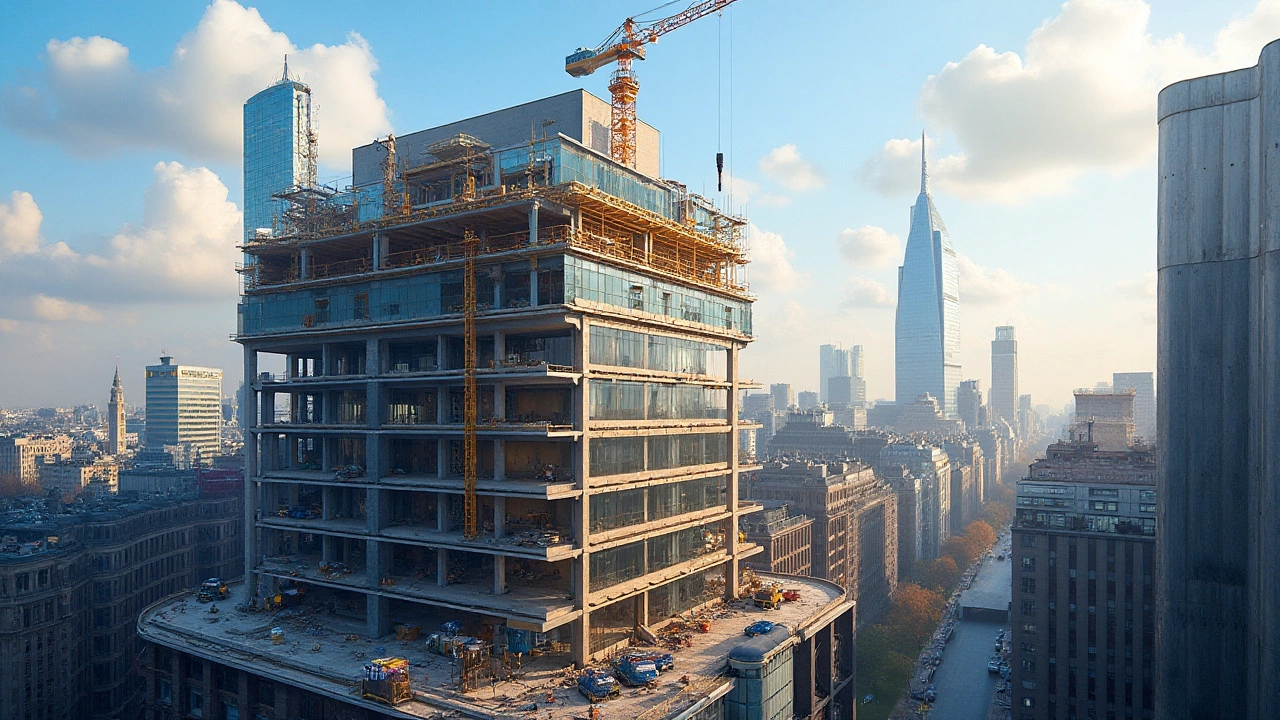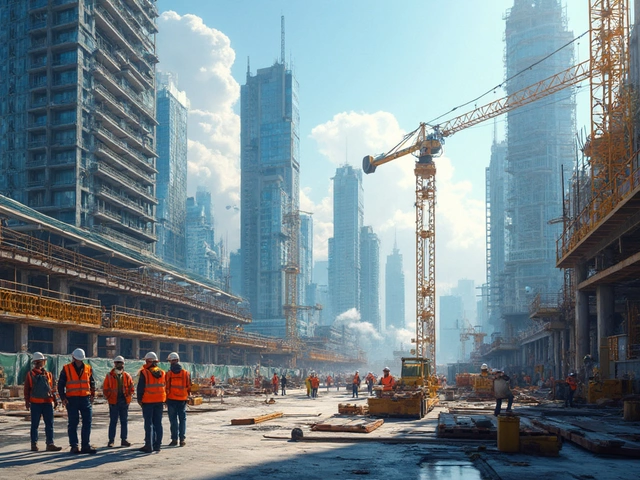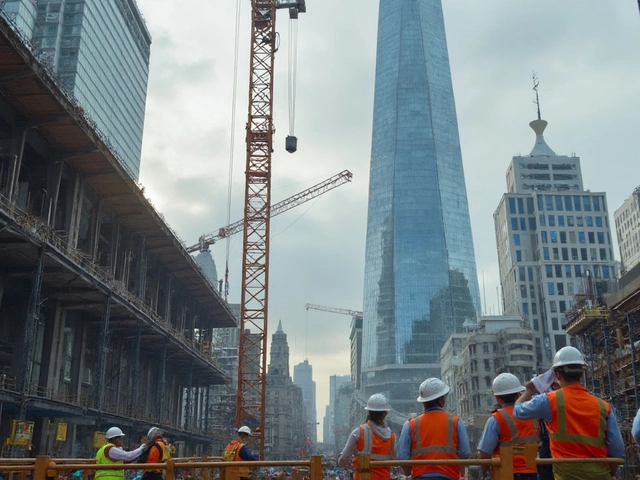The world of construction is vast, offering a myriad of opportunities and specialties. Two commonly discussed types are civil and commercial construction, each with its own unique focus and significance. Understanding the distinction between them can be crucial for anyone involved in or looking to embark on a construction project.
Civil construction plays a vital role in shaping the infrastructure of our communities. This branch generally tackles major public works such as roads, bridges, and water treatment plants, projects that are essential for ensuring the seamless operation of a city or town. On the other hand, commercial construction focuses on the development of buildings that cater to business needs. Think malls, offices, and hotels — these spaces are designed to serve economic transactions and facilitate commerce.
- Defining Civil Construction
- Understanding Commercial Construction
- Key Differences Explained
- Considerations for Choosing Construction Type
Defining Civil Construction
Civil construction is a cornerstone of modern society, underpinning the infrastructure that supports everyday life. It encompasses a broad range of projects, primarily focused on creating and maintaining public works. This includes roads, bridges, dams, and water supply systems, each contributing significantly to the functionality and development of communities. Such projects not only enhance connectivity and facilitate transportation but also ensure the management and distribution of essential resources like water and electricity.
The breadth of civil construction means it often involves substantial planning and coordination, often backed by state or federal funding. These projects are usually implemented by government agencies, providing services that meet public needs. Due to their scale, these initiatives sometimes require collaboration across various sectors, including engineering, urban planning, and environmental science. The complexity of civil construction projects is heightened by the need to balance development with environmental and social considerations, often involving rigorous assessments to minimize their impact.
In defining the scope of civil construction, one must consider the regulation that surrounds it. Zoning laws, environmental impact assessments, and building codes all play a part in how these projects are conceived and executed. Ensuring compliance with these regulations is critical, as civil construction projects often occur in sensitive or densely populated areas where safety and sustainability are paramount. To illustrate the importance of civil construction, the American Society of Civil Engineers provides a comprehensive evaluation, noting, "Civil construction is integral to economic strength, creating a network that allows for growth and prosperity."
A fascinating aspect of this field is the technology and innovation driving it forward. Advanced materials, like high-strength concrete and novel composite materials, are increasingly being used to enhance the durability and sustainability of projects. These advancements are coupled with cutting-edge techniques like Building Information Modeling (BIM) and Geographic Information Systems (GIS), which help in planning and managing infrastructure projects with greater precision and efficiency. A survey by the National Association of Home Builders highlighted that incorporating technology in civil construction projects could reduce operation and maintenance costs by as much as 20%. This data exemplifies the evolving nature of the field.
In summary, civil construction is more than just a segment of the construction industry; it is the lifeblood of a nation's infrastructure, connecting cities, supporting economic growth, and improving the quality of life for its citizens. While its projects may not always grab headlines compared to commercial ventures, the impact they have on society is undeniable and extensive. From the roads beneath our feet to the bridges spanning great rivers, civil construction is about creating structures that matter, ensuring progress and sustainability for generations to come.

Understanding Commercial Construction
Commercial construction is a dynamic and ever-evolving sector, primarily focused on projects intended for business purposes. These projects can range from the towering skyscrapers that shape a city’s skyline to sprawling shopping centers. They play a pivotal role in defining urban landscapes, providing spaces where people can work, shop, dine, and stay. One of the interesting aspects of commercial construction is the variety it encompasses. There is a vast array of building types under this umbrella, each requiring specific design considerations and construction methods. From mixed-use developments to specialized facilities like hospitals and airports, the diversity of projects demands a comprehensive approach.
Financial aspects and economic implications are at the heart of commercial construction. Unlike civil projects, which are mostly government-funded, commercial buildings are typically privately financed. Real estate developers invest heavily, expecting substantial returns. This financial model means there is a keen focus on cost management and efficiency, as budget overruns can directly impact profitability. Contracts often adhere to strict schedules to ensure rapid completion and minimize holding costs.
Another fascinating element is the regulatory framework governing commercial construction. Building codes, zoning laws, and architectural standards must all be meticulously navigated to ensure compliance. Each jurisdiction has its own set of rules, often tailored to the local environment and community needs. For instance, zoning laws can affect the height and size of a building, sometimes dictating even the aesthetic elements. In this environment, understanding the regulatory landscape is as crucial as mastering the technical specifics of construction.
Technological advancements play an influential role in shaping modern commercial construction. Incorporating intelligent design principles and sustainable building practices is becoming more commonplace. The use of Building Information Modeling (BIM) facilitates the seamless coordination of various design, engineering, and construction tasks. Materials with lower environmental impact, like recycled steel, are increasingly popular. As a result, many new commercial buildings aim for certifications like LEED or BREEAM, which highlight their commitment to environmental stewardship.
As noted by the American Institute of Architects, "Smart buildings are not just an aspect of progress, they're the future of commercial development."
The importance of location cannot be overstated in commercial construction. Choosing the right site can significantly influence a project's success; it impacts accessibility, attracts foot traffic, and optimizes return on investment. Developers often study market demographics, traffic patterns, and nearby amenities to pinpoint the ideal location. Additionally, proximity to public transport and potential for future growth can also enhance a site's appeal. With every building, commercial construction continues to transform and energize communities, providing spaces that not only meet present needs but can also adapt to the future.

Key Differences Explained
When examining the distinctions between civil construction and commercial construction, it's essential to start with the purpose and scope of these projects. Civil construction primarily revolves around infrastructure development. This can encompass what are known as public works projects like highways, bridges, tunnels, and water supply facilities. These endeavors are often funded by the government with the goal of improving or maintaining the public’s quality of life. In contrast, commercial construction focuses on structures intended for commercial use — buildings such as shopping malls, warehouses, office complexes, and the like. The private sector often spearheads these projects with a profit-driven motive.
Regulations play a significant role in differentiating these two types of construction. Civil projects must adhere to strict governmental regulations due to their impact on public safety and environmental standards. The approval processes for these projects can be extensive, often requiring multiple levels of review to ensure compliance with a multitude of regulations. In commercial construction, while regulatory compliance remains crucial, the focus is often on building codes and zoning laws that ensure the safety and suitability of a structure for its intended commercial purpose. These considerations are critical as they can significantly influence the project's timeline and cost.
Another key area of difference lies in project scale and complexity. Civil construction projects are often much larger in scale and can involve sophisticated engineering feats, requiring collaboration between architects, engineers, city planners, and government officials. The timelines for these projects can stretch over several years, influenced by factors like weather conditions, funding, and public interest. A commercial construction project, in contrast, may vary in size from a small retail outlet to a sprawling corporate headquarters but typically involves shorter timelines driven by market demands and investment returns. A commercial project's complexity is often defined by its functionality, aesthetics, and adherence to brand identity rather than engineering challenges.
In terms of funding, civil construction is frequently financed through public means such as government budgets or public-private partnerships. These projects often serve a broader societal benefit and are scrutinized for cost-effectiveness and transparency. Commercial construction, on the other hand, is largely a private investment, susceptible to market trends and economic shifts. The decision to initiate or halt a commercial project can be much more fluid, with investors closely monitoring economic indicators and consumer trends. An interesting fact is that according to the American Society of Civil Engineers, it is estimated that over $4 trillion will need to be invested in U.S. infrastructure by 2030 to maintain and improve existing facilities, underscoring the massive scale often associated with civil endeavors.
The labor force in both sectors also differs somewhat. Civil construction may require highly specialized skills related to heavy machinery operation and large-scale project management. Workers need to adapt to varied terrains and often challenging conditions. Conversely, commercial construction often demands a wide range of expertise from interior design and architecture to HVAC systems and modern building techniques tailored for comfort and efficiency. As a quote from the Construction Manager Monthly puts it,
"While both sectors require skilled labor and careful planning, the edge in commercial construction often lies in its ability to innovate rapidly in response to market needs."

Considerations for Choosing Construction Type
When it's time to embark on a construction project, discerning whether to pursue a civil construction or commercial construction venture can be pivotal. The decision rests not just on the end purpose of the project, but also on a multitude of other factors, including budget, location, and project scale. Evaluating these elements meticulously can spell the difference between a successful endeavor and an undertaking fraught with unforeseen challenges.
One primary consideration lies in understanding the scope and scale of the project. Civil construction typically involves large-scale tasks that cater to public infrastructures like bridges, highways, and water reservoirs. These projects demand not only extensive planning but also substantial financial and human resources. The timeframe for completion might also span several years, given the complexity and size of the typical civil construction projects. Meanwhile, commercial construction projects, which include building spaces such as office buildings, retail outlets, and restaurants, usually range from small to medium-sized undertakings. Although they can also be extensive, especially for developments like shopping malls, the commercial construction process is often more standardized, with well-trodden paths from inception to completion.
The intended use and zoning regulations also play crucial roles in deciding between these construction types. For instance, you cannot just start plotting for a commercial mall on land designated for civic or agricultural use without proper rezoning permissions. On the flip side, civil projects often require governmental approval and extensive public consultation, given their community-wide impact. Navigating these regulatory landscapes demands patience, meticulous paperwork, and an understanding of legal frameworks.
"Understanding the regulatory steps involved in construction projects, whether civil or commercial, is crucial to preventing delays and legal pitfalls," notes renowned urban planner Jane Smith, who has overseen numerous large-scale infrastructures across the country.
Budgetary constraints and financial planning are equally pressing considerations when weighing your options. Civil projects typically boast monumental budgets, which might be daunting for smaller organizations or municipalities without adequate funding or governmental backing. On the contrary, while still potentially costly, commercial construction can sometimes offer more leeway for budgeting, especially with flexible financing options available through private investors or partnerships.
Lastly, one must consider the project's impact on the environment and community. Civil constructions, due to their vast reach, tend to have significant environmental and social implications. Thus, incorporating sustainable practices and technology becomes paramount to mitigate potential detriments. Commercial ones can also significantly sway an area's socio-economic landscape, altering traffic patterns, local economy, and even residential dynamics.
Facing such pivotal decisions, comprehending all these facets and aligning them with your organization's objectives is essential. Ensuring that the chosen path not only leads to economic or infrastructural enrichment but also contributes positively to the community and environment speaks volumes about a project's success and sustainability.







